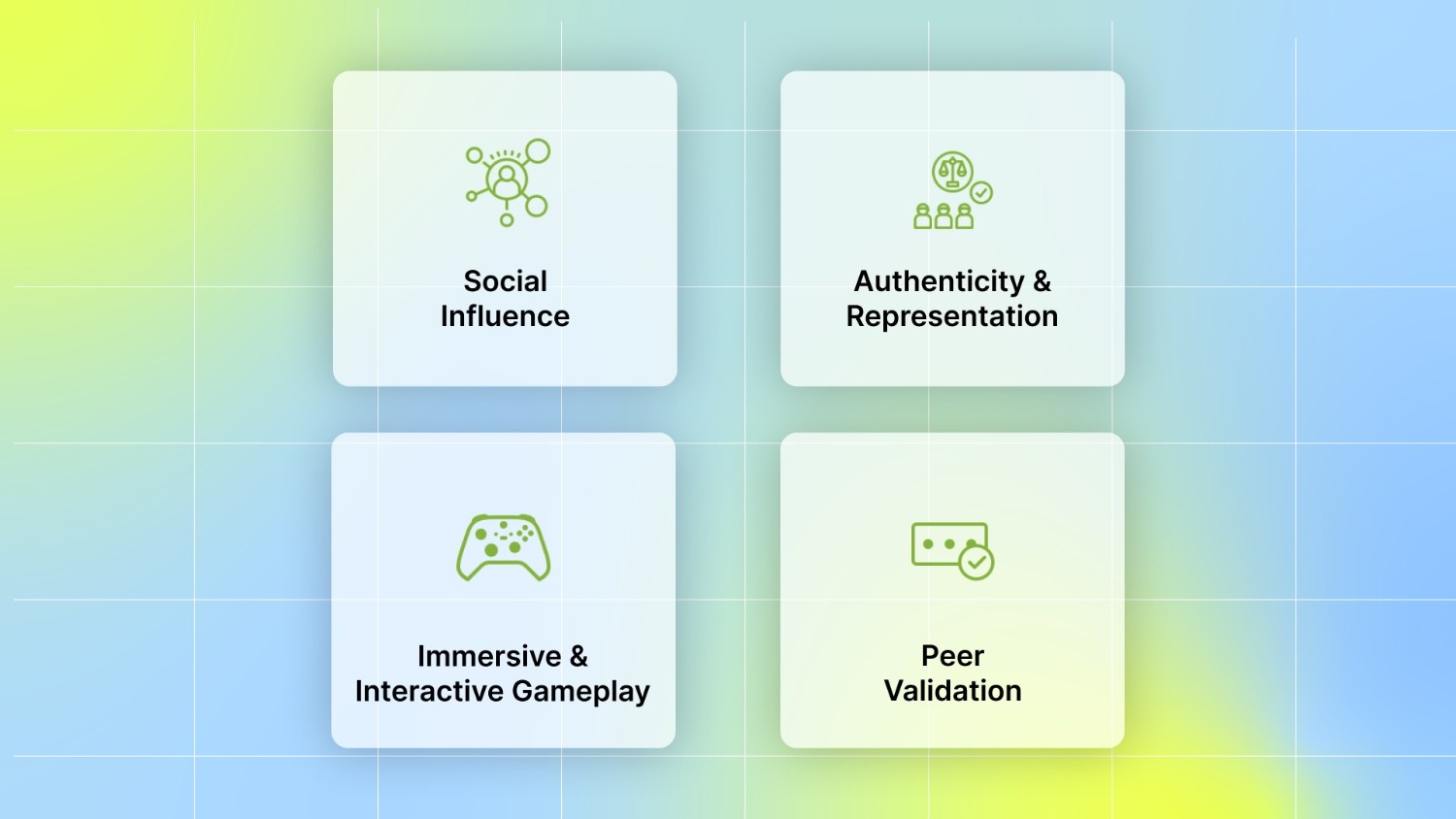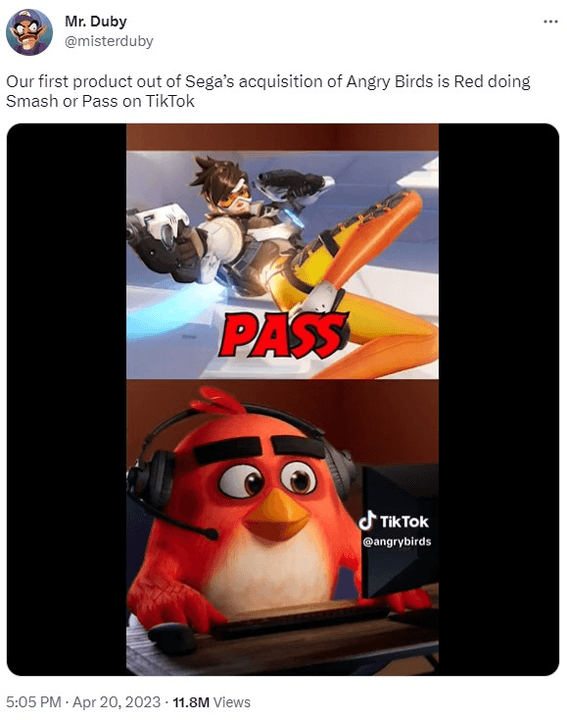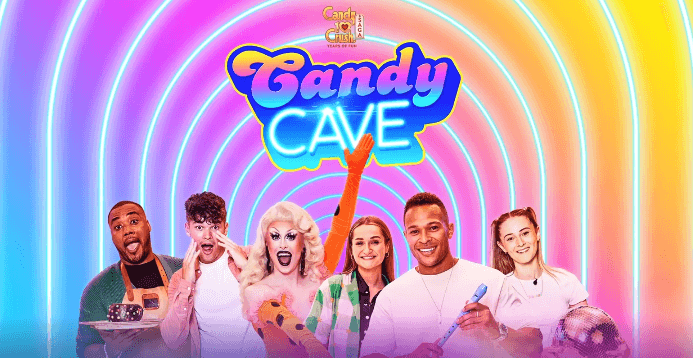Marketing to Gen Z: Key Strategies for 2025
Are you struggling to capture the attention of Gen Z gamers? With nearly 75% of Gen Z engaging in digital gaming by 2027, their influence on the mobile gaming market is undeniable. This generation is redefining gaming experiences, favoring platforms that offer social interaction, creative expression, and immersive environments.
Understanding unique behaviors and preferences is crucial for effective Gen Z marketing. Are you also finding it challenging to create engaging campaigns that resonate with them?
This blog covers essential strategies to enhance user acquisition efforts, including leveraging AI-driven creative analytics, optimizing ad placements, and utilizing predictive ROAS tools. By aligning your marketing efforts with Gen Z's gaming habits and expectations, you can foster deeper engagement and drive sustained growth for your mobile game.
Understanding Gen Z’s Decision-Making Process

Traditional tactics often fall short when it comes to engaging Gen Z in mobile gaming. This generation values authenticity, social connection, and immersive experiences. Understanding how Gen Z evaluates mobile games is essential to capturing their attention and keeping them engaged. Several key factors shape their decision-making process:
Social Influence: Gen Z often discovers new games through friends, influencers, and online community recommendations. Platforms like TikTok and YouTube, where gameplay videos and reviews are shared, play a significant role in their discovery process.
Authenticity and Representation: Gen Z seeks authenticity and diversity in the games. Games that reflect their values, identity, and real-life experiences are more likely to capture their attention and maintain their interest.
Immersive and Interactive Gameplay: They favor games that offer immersive experiences, with features like interactive storylines, customizable avatars, and social elements. These features make them feel more connected to the game and its community.
Peer Validation: Before committing to a game, Gen Z often looks for validation from their social circles. Positive reviews, shared experiences, and word-of-mouth recommendations are crucial to influencing their decision to download and engage with a game.
To successfully engage Gen Z, your marketing strategies must reflect their core values. Start by creating content that speaks to their desire for authentic experiences and a sense of community.
For example, integrating social features like sharing and collaboration can make your game more appealing to them. Personalizing in-game experiences and celebrating player achievements can strengthen their connection with your game. By aligning your marketing efforts with what Gen Z cares about, you’ll increase engagement and build a loyal player base that will stick with your game.
Now that you understand Gen Z's decision-making process, let's explore key strategies to convert their interest into loyal players for your mobile game.
Key Strategies to Convert Gen Z Prospects
To effectively convert Gen Z prospects into engaged users for your mobile game, focus on strategies that resonate with their values and behaviors. This generation seeks authenticity, social connection, and immersive experiences. By aligning your marketing efforts with these preferences, you can enhance user acquisition and retention.
Hyper-Personalized Creative Optimization
To effectively engage Gen Z in the mobile gaming market, it's crucial to align AI-driven creative strategies with their distinct preferences. This generation values authenticity, diversity, and interactive experiences. By using AI to analyze successful ad creatives, you can identify elements that resonate with Gen Z, such as emotionally compelling narratives and inclusive character representation. Incorporating these insights lets you develop personalized campaigns that capture attention and foster a deeper connection with Gen Z audiences.
Example
Consider the mobile game FashionVerse by Tommy Hilfiger. The game utilizes generative AI to enhance 3D avatars and outfits, enabling players to style lifelike characters in a virtual environment. This approach not only appeals to Gen Z's desire for personalization but also integrates seamlessly with their gaming experiences, demonstrating the power of AI-driven creative optimization in action.
Look for commonalities in hooks, pacing, visual elements, and character representation. Utilize AI tools to analyze these components and generate insights that can inform the development of future ad creatives. By consistently applying these insights, you can enhance the effectiveness of your campaigns and better connect with Gen Z audiences.
Also Read: Generating Successful Ad Creatives with AI
Predictive Playable Ad Testing
Gen Z gamers seek interactive and immersive experiences that let them engage with a game's core mechanics before committing to a download. Playable ads offer this "try-before-you-buy" experience, enabling potential players to interact with a mini-version of the game. When combined with AI-driven predictive analytics, these ads can forecast player retention and return on ad spend (ROAS) before scaling campaigns, ensuring marketing resources are allocated efficiently.
Example
Survivor.io, developed by Habby, achieved significant success by integrating high-performing playable ads into its user acquisition strategy. The game utilized TikTok as a primary channel, dedicating 50% of its budget to this platform. The viral spread of creative gameplay videos, coupled with engaging playable ads, led to a reduced cost per install (CPI) and boosted ROAS. This approach highlights the effectiveness of combining engaging ad formats with strategic platform selection to optimize user acquisition efforts.
The primary goal of playable ads is to capture attention and drive installs. Testing and optimizing playable ads is crucial to effectively engaging Gen Z. Focus on gameplay difficulty, interaction flow, and creative style to discover what resonates most with this audience.
For instance, adjusting the difficulty curve to match Gen Z's preference for balanced challenges can enhance engagement. Gen Z values quick, immersive experiences that feel authentic. Aligning your ad’s tone and challenge level with these expectations can boost engagement and lead to better conversion outcomes, ultimately improved user acquisition outcomes.
Also Read: How Idle Weapon Shop Cracked the Creative Code: 300M+ Playable Ad Impressions
Social Listening + Creative Iteration
To effectively engage Gen Z in mobile gaming, it's essential to stay attuned to their rapidly shifting interests. Platforms like TikTok and Instagram serve as barometers for trending content, memes, and cultural references. By leveraging social listening tools, you can monitor these trends and swiftly adapt your ad creatives to resonate with Gen Z's current preferences.
Social listening tools are essential for staying attuned to Gen Z's dynamic interests in mobile gaming. These platforms monitor social media conversations, identifying trending topics, memes, and user sentiments. By analyzing this data, you can swiftly adapt your marketing strategies to resonate with your audience. This approach ensures that your marketing efforts remain relevant and engaging, capturing the attention of this dynamic audience.
Example

A standout example of utilizing social listening and creative iteration comes from the Angry Birds franchise. After Sega acquired Angry Birds, they took advantage of TikTok's popular Smash or Pass challenge by featuring Red, the iconic character, in this viral trend. A tweet by Mr. Duby showcasing the video garnered an impressive 11.8 million views, with Red humorously participating in the Smash or Pass format.
This timely response not only boosted visibility but also resonated with the younger demographic. It highlights the power of using social listening tools and swiftly iterating on ad creatives to engage Gen Z in relevant and timely ways.
To capitalize on this strategy, set up alerts for trending hashtags or memes relevant to your game's theme. Ensure your creative team can adapt and implement these trends into your ad creatives within 24 hours. This agility will let you capitalize on viral moments, keeping your game top-of-mind for Gen Z users and enhancing user acquisition efforts.
Micro-Influencer Campaigns with Performance Tracking
Partnering with nano and micro-influencers, those with 5,000 to 50,000 followers, can be a game-changer in effectively capturing the attention of Gen Z gamers. These influencers boast high engagement rates and a strong sense of community, making their endorsements more authentic and impactful.
Example


In celebration of Candy Crush Saga's 10th anniversary, King, the game's developer, collaborated with influencer marketing agency Billion Dollar Boy to launch the "Candy Cave" campaign. This initiative aimed to rejuvenate the game's appeal among Gen Z and Millennial audiences by leveraging the power of content creators.
The campaign introduced a Dragon's Den-style series where popular UK creators pitched their imaginative "funtasies" creative interpretations inspired by Candy Crush. These pitches were then brought to life and shared across social media platforms, including YouTube and TikTok, amassing millions of views and significant engagement from younger audiences.
Notably, the campaign featured prominent Gen Z influencers such as drag superstar Bimini, Chicken Shop Date host Amelia Dimoldenberg, comedian Munya Chawawa, and YouTuber Chunkz. Their involvement added authenticity and relatability, resonating deeply with the target demographic.
AI-Powered Creative Fatigue Detection
As a mobile game marketer targeting Gen Z, you're well aware of their dynamic preferences and the need to keep your campaigns fresh and engaging. However, even the most captivating creatives can lose effectiveness over time due to creative fatigue, a common challenge in the mobile gaming industry. To combat this, implementing AI-powered creative fatigue detection can be a game-changer.
By leveraging AI, you can automatically monitor key performance indicators like Click-Through Rates (CTRs) and Install Per Mille (IPM), receiving timely alerts when these metrics begin to decline. This proactive approach lets you refresh your creatives before performance plateaus, ensuring sustained engagement and optimal Return on Ad Spend (ROAS).
Example
Brain Out, a popular mobile puzzle game, effectively combats creative fatigue by regularly updating its ad creatives. The game employs variations in backgrounds, CTAs, and ad copy to maintain user engagement and prevent ad fatigue. This approach ensures that the ads remain fresh and appealing to the target audience.
To effectively combat creative fatigue, set up automated rules within your advertising platform to pause underperforming ad variants and reallocate the budget to top-performing creatives. Regularly analyze performance metrics and refresh your creatives based on AI-driven insights to maintain Gen Z's interest and maximize user acquisition efforts.
Implementing AI-Driven Monitoring
Utilizing AI-powered tools lets you monitor the performance of your ad creatives. These tools analyze various elements like backgrounds, calls-to-action, characters, and hooks to identify creative fatigue patterns.
For instance, if a particular creative's CTR drops below a certain threshold or if engagement metrics decline after a specific frequency, the AI can alert you to refresh or replace that creative. This proactive approach ensures that your ads remain compelling and effective, reducing the risk of audience disengagement.
To streamline this process, consider leveraging Segwise's AI-powered tools:
Creative Agent: Creative Agent utilizes multimodal AI to automatically tag and analyze creative elements such as backgrounds, calls-to-action, emotional hooks, and more across various ad formats, including videos and playables. This automation saves time and provides insights into which creative components resonate most with your audience.
Campaign Monitoring Agent: The Campaign Monitoring Agent automatically fetches and analyzes data from Mobile Measurement Partners (MMPs), alerting you to any anomalies or issues in your campaign performance. This proactive monitoring helps you address potential problems promptly, ensuring your campaigns remain effective and efficient.
By integrating these tools into your marketing strategy, you can proactively manage creative fatigue, optimize your ad creatives, and maintain high engagement levels among Gen Z gamers.
Conclusion
Effective Gen Z marketing for gamers in 2025 requires a deep understanding of their preferences and behaviors. This generation values authenticity, community, and immersive experiences. To capture their attention and drive user acquisition, it's essential to leverage strategies from hyper-personalized creative optimization to AI-powered creative fatigue detection. By aligning your marketing efforts with Gen Z's gaming habits and expectations, you can foster deeper engagement and drive sustained growth for your mobile game.
To implement these strategies effectively, consider leveraging Segwise, an AI-powered platform designed for mobile game marketers. Segwise offers AI-powered tools to automate creative tagging and deliver deep insights to optimize return on ad spend (ROAS). With seamless integration across major ad networks and Mobile Measurement Partners (MMPs), Segwise empowers you to make data-driven decisions.
So, are you ready to elevate your user acquisition strategy and connect more effectively with Gen Z gamers? Start your journey by signing up for a 14-day free trial today!.
FAQs
1. How can AI help optimize mobile game campaigns for Gen Z users?
AI allows marketers to analyze user behavior in real time, optimizing ad creatives, targeting, and personalization. It helps predict user actions, identify trends, and automate campaign management for faster, more efficient user acquisition (UA).
2.What role does user-generated content (UGC) play in Gen Z's mobile gaming preferences?
Gen Z values authenticity and interaction, making UGC a key factor in their engagement. Playable ads and content created by real users or influencers often perform better in driving installs and retention than traditional advertising methods.
3.How do micro-influencers impact mobile game UA campaigns for Gen Z?
Micro-influencers, with their smaller, niche audiences, have higher engagement rates than macro-influencers. Their recommendations feel more authentic to Gen Z, making them effective in driving installs and increasing brand trust for mobile games.
4.What are the best practices for avoiding creative fatigue in Gen Z campaigns?
To avoid creative fatigue, regularly refresh ad creatives by changing visual elements, messaging, and CTAs.

Comments
Your comment has been submitted successfully!